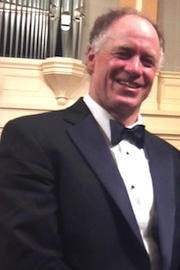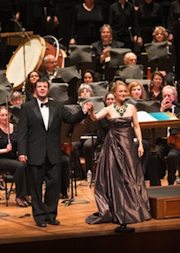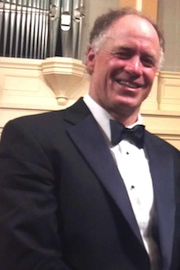
Photo by Geneva Anderson
San Francisco Choral Society Artistic Director Robert Geary says:
Every five or six years the San Francisco Choral Society performs the music of Johannes Brahms. I think we all feel a great sense of privilege to have the opportunity to re-discover the deep human affinity Brahms expressed through his absolutely gorgeous and compelling harmony and melody.This sense of privilege is made all the greater by being able to perform with Marnie Breckenridge and Eugene Brancoveanu, both artists of the highest caliber, deserving of the international acclaim they have earned.
The German Requiem is among the very few works of the genre in German, non-liturgical and focuses on humanism and how "Death is swallowed up in victory." Brahms' letters include references to second thoughts about the work's name, that "Human" would have been more fitting than "German."
Brahms first contemplated writing a Requiem in 1856 upon the death of Robert Schumann, a close friend. At 23, Brahms might have been one of the youngest composers ever to consider writing about death (poets are different). Ten years later, when his mother died, Brahms completed the work in 1866.
The text is compiled from Martin Luther's German translation of the Bible. After completing the work, Brahms wrote: "Now I am consoled. I have surmounted obstacles that I thought I could never overcome and I feel like an eagle, soaring ever higher."
For Brancoveanu, it's the third time to sing the mighty "For here we have no lasting place" aria:
I find something new in the piece every time I sing it. It has a youthfulness about it that I find in no other requiem or mass. As if the chorus and the soloist yell to the heavens seeking connection out of fear.I am very excited to be singing with Marnie again and the wonderful SF Choral Society. Having grown up with both Romanian and German, the text has an added intimacy for me.

More than 200 singers will participate in the chorus for the Ein Deutsches Requiem performances, the California Symphony will accompany. Also on the program is Brahms’ Nänie, the German form of the Latin "nenia," meaning a song of lamentation. Composed in 1881, after the death of painter Anselm Feurebach, the 15-minute work is rarely performed, Geary says, because it is extremely difficult. The text is by Friedrich Schiller (of "Ode to Joy").
Junior and senior high school students are invited to attend these concerts for free. For admission, e-mail [email protected] with your name and school. The student program is supported by the Wells Fargo and Bernard Osher Foundations.

